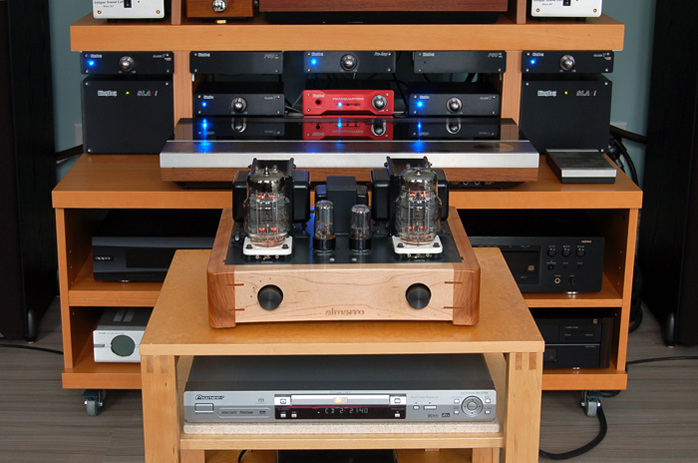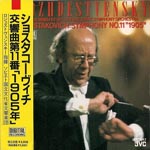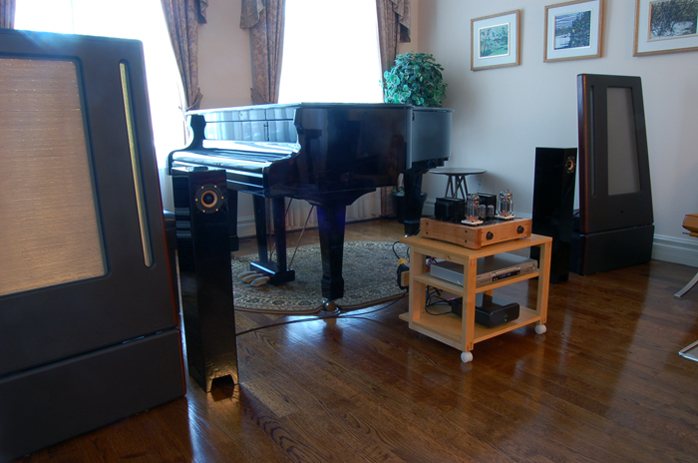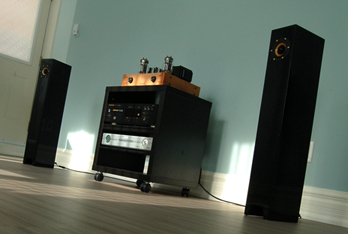This review page is supported in part by the sponsors whose ad banners are displayed below |
 |
 |
|
| I placed the JB3F 80" apart axis to axis, backed off 3’ from the wall driven by the Almarro 318B. Just imagine the visual contrast: the slender JB3F standing 27" above the floor with just a tiny 3" driver versus the quad-amped Loth-X BS-1 towering 65" tall, poised 11’ apart and flaunting eight 6" widebanders and eight 1" tweeters. When music played through the two systems respectively, the picture to my mind wasn’t of David and Goliath but a more earth-shattering biblical scene: Samson pulling down the two pillars of the Temple of Dagon.
With a pair of 3" drivers firing at much below ear level, the soundscape projected by the JB3F filled up the entire wall from corner to corner, floor to ceiling. Depth protruded beyond the physical limitation of the wall and could only be curbed by an unwillingness to imagine. To be fair it had partly if not largely to do with the recording I was listening to Quiet Winter Night [2L-087-PABD], a captivating folk-flavoured Jazz project performed by Hoff Ensemble. |
|
|
In fact a lot of the 2L small ensemble recordings have this incredible sonic quality of weaving out the musical fabric at the highest possible thread count. They are the high fashion of the recording industry and the JB3F wore it well, completely concealing its physical shortcoming. (Ironically I only spun a FLAC 16/44 CD burnt off the mShuttle feature on the Blu-ray disc. Digital source was a cheap Pioneer DV-578A DVD/SACD player coupled to the very musical bitstream Deltec Little Bit DAC.) With the Almarro’s volume knob at the 9 o’clock position, the JB3F sounded as rich as the quad-amped Loth-X. Poetic songs were presented with ethereal beauty, delicate passages were diaphanous. When I reduced the opponents’ quad amps to bi amps, the JB3F actually surpassed them.
|
 |
So what is the Achilles heel of the JB3F? Complex symphonic works like Shostakovich Symphony No.11 '1905'. The version I picked was Gennady Rozhdestvensky’s 1983 recording with the USSR State Symphony Orchestra [JVC Melodiya VDC-1042].
|
 |
It sounded quite promising in the first movement "Palace Square" and the suspense-full atmospheric tension was closely knit. But in the second movement "Ninth of January" when the orchestra built into a brutal climax, the JB3F could not match the scale and scope one expects for this monumental work even when I dialled up the volume on the Almarro. Now the musical data became pixilated. Most early digital recordings have been criticized for not sounding analogue and this is one of them. Distant miking in large concert halls sometimes exposes the low thread count in the musical fabric when played back through small speakers. Upsampling and monstrous systems are good remedies. But I found another effective if non-scientific therapy which is playing them through more amps and speakers like the quad-amped Loth-X here. Acoustic interpolation if you will. I hate using the phrase but if it does help communicate my point, it sounds absolutely analogue. |
|
|
|
|
Exhibit 2: Apogee Stage bi-amped with NuForce P9/Reference 9 V2. The consensus of my friends is that this is my best conventional stereo setup. Considering its total radiating area is 100 times higher than that of the 3" drivers, the JB3F’s performance was admirable. Perhaps the TQWT sparked off some coupling magic with the hardwood floor on joists as opposed to padded laminated flooring on a concrete slab in the basement but the JB3F sounded more spacious and the soundstage expanded disproportionately for its size. The soundboard of the Estonia parlor grand also contributed I presume. With flattering recordings like Quiet Winter Nights and Pink Floyd Classical Concept, the JB3F was absolutely engaging.
|
 |
If the NuForce/Apogee Stage system gave me a lifelike presentation of a grand piano performing on stage, the Almarro/JB3F was like a friend playing for me on an upright piano in a private musical soiree. There are many exquisitely beautiful upright pianos and the JB3F sounded exactly like that. The timbre, tonal spectrum, expressiveness and dexterity were all palpably there within arm’s length. The musical experience was utterly personal and intimate.
If you value musical emotion over sonic sensationalism, the JB3F is for you. When listening to the JB3F, I easily submerge into musical involvement and my brain shuts off searching for hifi attributes. This made penning this review harder. The musical aura it conjured up simply wrapped itself around me wherever I sat. As long as I am in the same room or within audible range, I enjoy the music to the fullest. When music is this intimate, any spot is the sweet spot.
|
|
|
|
 |
Of course this is all my imagination. Without the visual perception of a live concert, we all imagine things and then describe them in words. But it was the JB3F which invoked such imagination in the first place. Most people think that one of the intrinsic qualities of single drivers is their naturally spontaneous soundstaging. The JB3F certainly misses none of that. But it would be sacrilege if I just sat there to appreciate its pinpoint imaging. The hardest but most desirable thing for any piece of hifi equipment to achieve is to arouse and heighten the listener’s musical sentiment and let it triumph over sonic effects and audiophile attributes. The JB3F cast such a spell on me and turned me into a complete sentimentalist. Sniff...! |
|
|
|
 |
 |
|
 |